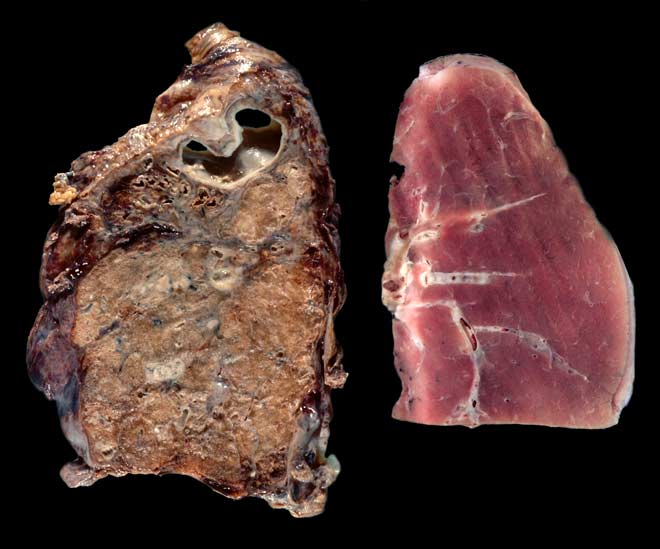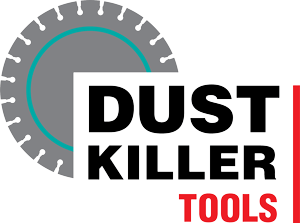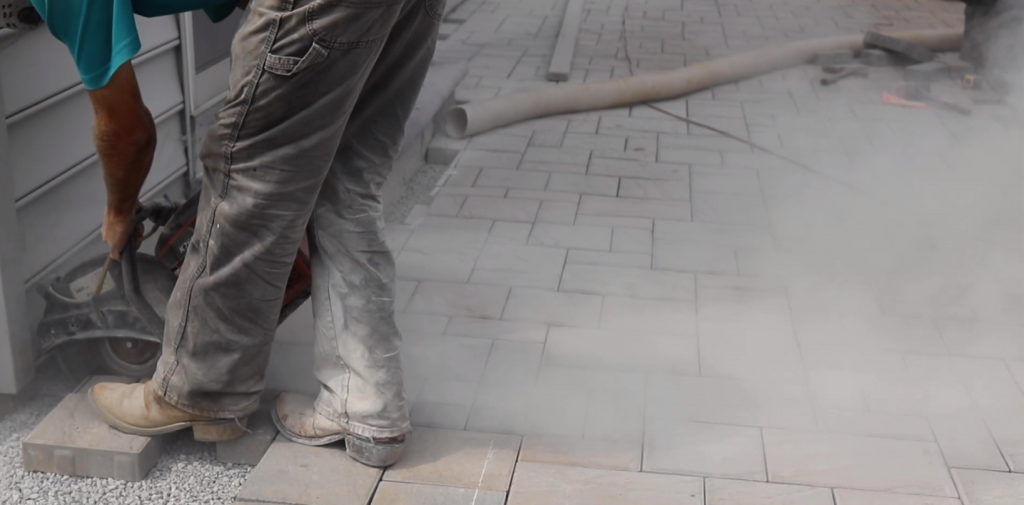What is Respirable Crystalline Silica?
Crystalline silica is mineral found everywhere on our jobsites… sand, concrete, brick, block, stone, and mortar. And yes, even in dirt!
Respirable crystalline silica is about 100 times smaller than particles of sand found on beaches. It is generated by cutting, sawing, grinding drilling, and crushing the above materials.
Breathing in Crystalline Silica dust is extremely detrimental to ones health. If you are a hardscape installer whos work requires cutting concrete bricks, then you need to be aware of the risks and know the symptoms of silicosis.
Why is OSHA concerned?

Silicosis is caused by breathing respirable silica dust on an ongoing basis. As silica enters the lungs, it causes formation of scar tissue which limits oxygen absorption. THERE IS NO CURE. Severe cases can be disabling or fatal.
Silicosis also affects the immune system, and typically occurs after 15-20 years of occupational exposure to respirable silica.
In addition, the risk of lung cancer and other lung diseases are increased by exposure to respirable silica as is the risk of kidney disease.
Sadly, silicosis continues its progress even after exposure is discontinued as the particles remain in the lungs and continue damaging them.

Credit: Te Ara Encyclopedia of New Zealand
The lung on the left has silicosis and the lung on the right is healthy.
What Are the Symptoms of Silicosis?
The American Lungs Association warns us that silicosis is an insidious disease that can take many years to fully manifest. An early sign is coughing. The coughing will develop over time as the employee is continually exposed to silica dust.
“In acute silicosis, you may experience fever and sharp chest pain along with breathing difficulty. These symptoms can come on suddenly.”
American Lungs Association
Other symptoms of silicosis are:
- Shortness of breath
- Severe cough
- Trouble breathing
- Weight loss
- Chest pain
- Lack of oxygen
- Blueish coloration
Safety + Health tells us from 1999 to 2013 silicosis killed 2,065. It is a serious health condition that is avoidable with proper silica dust collection equipment. It takes about 10 years after exposure to develop silicosis.
Why are We Concerned?

Our workers deserve better.
All industries have some hazards. A desk job might have a risk of carpal tunnel syndrome. Continual exposure to silica dust will harm some of your employees. All employers have a moral and legal obligation to reduce workplace hazards.
OSHA will put us out of business for non-compliance.
We put ourselves at risk for not implementing these safety measures. Even the lowest penalty is $8,065 per person exposed to silica. A more “serious violation” is up to $12,934 per violation. Procrastinating can result in fines such as: “Failure to abate” is up to $12,934 per day and “Willful or Repeated” is up to $129,336 per violation. No one can afford a fine like the Lanford Brothers’ record fine of $304,000!
Lanford Brothers’ Record $304,000 fine
- Failure to use water to control silica dust while operating jackhammers. Proposed Penalty: $96,000. Willful-serious violation.
- Failure to assess the exposure of each employee exposed to silica dust. Proposed penalty $96,000. Willful-serious violation.
- Failure to provide medical examinations as required. Proposed penalty $96,000. Willful-serious violation.
- Failure to train temporary workers on hazards of silica. Proposed penalty $8,065. Serious violation.
- Workers & superintendent not wearing eye protection while operating a jackhammer. Proposed Penalty $8,065. Serious violation.
Lanford has faced violations in the past, including a scaffolding violation in June 2017. This could have impacted fines for violating silica standard.
MEDICAL SURVEILLANCE
Employers must offer medical evaluations to employees who will be required to wear a respirator 30 or more days per year. Even if the respirator is required only 1 hour, that counts as a day!
The exam must be offered by NIOSH certified physician. It must be offered within 30 days of an employee starting a job that will require 30 or more days of respirator use in the next 365 days. Exams must be offered every 3 years.
Doctors must test the fit of the respirator, and ensure the employee is physically fit to use one.
Records must be maintained for 30 years after employment
We Have Created a Solution
The Dust Killer can solve many of these issues before they become an issue. Watch the video below to learn more. You can also contact us to learn more about our silica dust collection system.

